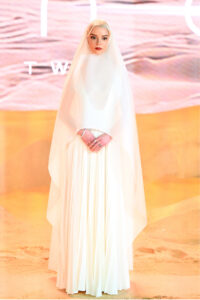Photos courtesy: Andrea Adriani, Koji Hirano, Kristy Sparow
Copy editors: Eishvinder Gill, Samira Balsara
Everyone’s trying to have their ‘Coperni SS23’ moment. Recently, brands have been experimenting with the runway more and more. From dresses cured with UV light to crowd-surfing models, fashion month has become a waiting game of the next viral show.
As for the “classic” runway presentation? Well, we’re still deciding if a brand’s success goes hand in hand with its virality. People across the internet have dubbed this phenomenon the ‘TikTokification’ of the runway.
Sure, innovative fashion presentations aren’t a new concept—McQueen’s SS99, one of fashion’s most beloved shows, was showcased before social media was a part of the fashion landscape. Brands like Chanel and Louis Vuitton, among others, have experimented with the runway for years.
So why does it feel like we’re in the era of viral fashion shows?
Take, for instance, (DI)VISION’s FW23 show at Copenhagen Fashion Week. The show was all over Instagram’s Reels, and for good reason; the finale featured a model masquerading as a guest, who stands up to pose and walk the runway. Her skirt, initially disguised as a tablecloth, drags along with her, while all the glasses, plates, and cutlery crash onto the floor.
@anna.winck @(di)vision ❤️🩹❤️🩹❤️🩹❤️🩹
♬ Bad Reputation – Joan Jett
People across Instagram and TikTok loved it.
ANREALAGE showcased a collection of colour-changing pieces, activated by suspended moving UV lights. Muslin-like garments transformed into bold and colourful patterned pieces. AVAVAV’s FW23 collection is another example. It focused on deconstructing the seriousness around fashion, showing the models tripping on the runway, their clothes, and accessories ‘falling off’ of their figures. Heliot Emil’s models channelled The Hunger Games, walking down the runway engulfed in flames, and Coperni’s FW23 show starred animal-shaped robots as models.
All of this in one season.
At first glance, it seems obvious why brands may want to experiment with presentations. Today’s fashion industry is directed by viewers—millions of them— who’ll then turn into customers, and later spread the word, raising brand awareness. Brands are no longer gatekeepers of fashion, but rather, brands are gatekept out of what we’d deem “mainstream fashion”.
The TikTokification of fashion seems like a win-win situation for both the brand and the viewer. So why does it seem to not work for so many audiences?
For some, the experimental showcase seems to take away from the clothes themselves; for others, it feels almost repetitive—or worse, an obvious marketing ploy—after the first few shows. To many, these shows seem like an attempt to create a viral moment, to entice the audience to record, and post the show.
But others—like myself—are always looking forward to the next fashion spectacle. Sure, it’s probably a marketing strategy, and sure—it’s frivolous and social-media centric. But, it can be extremely interesting, and not to forget fun, when it’s done right. Some brands, like AVAVAV, have connected their tongue-in-cheek presentations to their themes. Others have simply used the runway as another outlet for their identity.
One thing’s for sure, there’s always something extra to look forward to during fashion week.
























